Themed collection Editor’s Choice: Kaushik Chatterjee

Engineering extracellular vesicles derived from macrophages for tumor therapy: a review
Compared to cellular immunotherapy, engineering macrophage-derived EVs which carry nanoparticles, drugs, proteins, nucleic acids etc. can target tumor cells to improve biosafety and treatment efficacy.
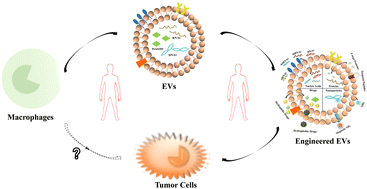
Mater. Adv., 2023,4, 1213-1225
https://doi.org/10.1039/D2MA00961G
Advancements in bacteriophage therapies and delivery for bacterial infection
Graphical representation of phage natural replication, molecular modification applications including CRISPR/Cas9, and delivery applications including hydrogels and liposome encapsulation for treatment of bacterial infections.

Mater. Adv., 2023,4, 1249-1257
https://doi.org/10.1039/D2MA00980C
Nanoparticle-mediated CRISPR/dCas9a activation of multiple transcription factors to engineer insulin-producing cells
Four gRNAs were synthesized and used to form ribonucleoproteins (RNPs) with tracRNA and dCas9-VPR, and were then immobilized on magnetic peptide-imprinted chitosan nanoparticles, which enhanced transfection for production of insulin.

J. Mater. Chem. B, 2023,11, 1866-1870
https://doi.org/10.1039/D2TB02431D
Fabrication of three-lobed magnetic microrobots for cell transportation
We present a bench-top colloidal approach for fabricating three-lobed magnetic microrobots. These microrobots showed promising results for single-cell transportation in a fluid.

J. Mater. Chem. B, 2023,11, 8926-8932
https://doi.org/10.1039/D3TB00613A
Highly active nanoparticle enhanced rapid adsorption-killing mechanism to combat multidrug-resistant bacteria
ANPQ coating exhibits rapid adsorption and efficient killing to multidrug-resistant bacteria, which undoubtedly made it a promising candidate in post-epidemic era.

J. Mater. Chem. B, 2023,11, 7750-7765
https://doi.org/10.1039/D3TB01105D
From energy storage to pathogen eradication: unveiling the antibacterial and antiviral capacities of flexible solid-state carbon cloth supercapacitors
Unleashing the versatility of supercapacitors: Uniting energy storage prowess with post-charging antibacterial and antiviral functionalities.

J. Mater. Chem. B, 2023,11, 8170-8181
https://doi.org/10.1039/D3TB01085F
Mesenchymal stromal cells modulate YAP by verteporfin to mimic cartilage development and construct cartilage organoids based on decellularized matrix scaffolds
Cartilage decellularized matrix scaffolds with different mechanical properties were prepared as bioactive material platforms to study the effect of mechanical signals on cells, and cultivated hyaline cartilage organoids in vitro.
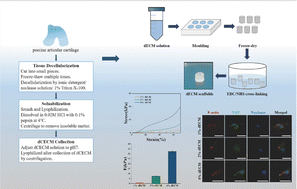
J. Mater. Chem. B, 2023,11, 7442-7453
https://doi.org/10.1039/D3TB01114C
Differentiation of snake venom using Raman spectroscopic analysis
We have proposed an economical express method based on Raman spectroscopy, which with the help of mathematical processing allows the classification of snake venoms according to their composition and the determination of snake family or even genus.
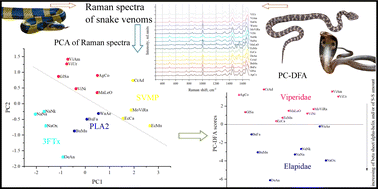
J. Mater. Chem. B, 2023,11, 6435-6442
https://doi.org/10.1039/D3TB00829K
Evaluating glioblastoma tumour sphere growth and migration in interaction with astrocytes using 3D collagen-hyaluronic acid hydrogels
Glioblastoma cells co-cultured with astrocytes in col-HA hydrogels exhibit changes in migration patterns. 3D in vitro models using ECM mimetic materials can be used to analyze glioma-astrocyte crosstalk.

J. Mater. Chem. B, 2023,11, 5442-5459
https://doi.org/10.1039/D3TB00066D
Interpenetrating network design of bioactive hydrogel coatings with enhanced damage resistance
An interpenetrating network design was used to enhance the toughness of PEG-based hydrogel coatings to resist damage during surgical handling.

J. Mater. Chem. B, 2023,11, 5416-5428
https://doi.org/10.1039/D2TB02825E
3D light-curing printing to construct versatile octopus-bionic patches
DLP 3D printing can not only realize the personalized customization and automatic operation of the octopus bionic patch, but also better the groove structure on the surface of the bionic octopus, which is conducive to enhancing adhesion.

J. Mater. Chem. B, 2023,11, 5010-5020
https://doi.org/10.1039/D3TB00590A
In vivo and In vitro properties evaluation of curcumin loaded MgO doped 3D printed TCP scaffolds
A schematic of sample preparation using 3D printing, assessment of in vivo rat distal femur model with the 3D printed curcumin loaded scaffolds, and demonstration of in vitro properties including osteosarcoma inhibition and antibacterial properties.
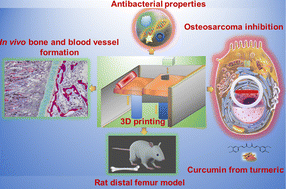
J. Mater. Chem. B, 2023,11, 4725-4739
https://doi.org/10.1039/D2TB02547G
Engineering ultrasound-activated piezoelectric hydrogels with antibacterial activity to promote wound healing
The piezoelectric hydrogels exhibited superior antibacterial effectiveness, prevent wound infection, and could hasten the healing of full-thickness skin wounds.
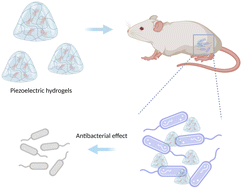
J. Mater. Chem. B, 2023,11, 4318-4329
https://doi.org/10.1039/D3TB00284E
Photomechanical response under physiological conditions of azobenzene-containing 4D-printed liquid crystal elastomer actuators
This work analyses the photomechanical work performance of 4D-printed liquid crystal elastomers under physiological conditions in PBS media.

J. Mater. Chem. B, 2023,11, 4083-4094
https://doi.org/10.1039/D2TB02757G
Functionalization of cellulose nanofibrils to develop novel ROS-sensitive biomaterials
Nanocellulose–oligoproline hydrogels, able to respond to high levels of ROS and protect cells from oxidative environments, are promising candidates for the treatment of chronic wounds and other clinical conditions associated with high levels of ROS.
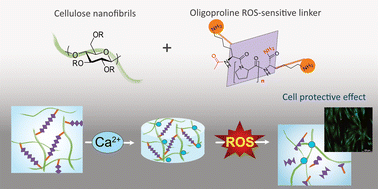
Mater. Adv., 2023,4, 1555-1565
https://doi.org/10.1039/D2MA01056A
Post-imprinting modification: electrochemical and scanning electrochemical microscopy studies of a semi-covalently surface imprinted polymer
Post-imprinting modification of imprinted molecular cavities with a ‘redox probe’ for electrochemical sensing.
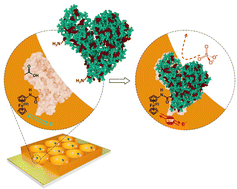
J. Mater. Chem. B, 2023,11, 1659-1669
https://doi.org/10.1039/D2TB02116A
Additively manufactured thermosetting elastomer composites: small changes in resin formulation lead to large changes in mechanical and viscoelastic properties
Better resin wettability increases strength and stiffness in high solids loading composites that can be additively manufactured with high resolution.
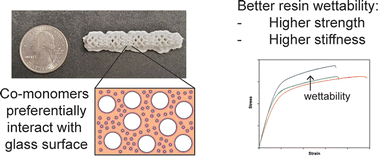
Mater. Adv., 2023,4, 607-615
https://doi.org/10.1039/D2MA00892K
Biodegradable porous FeMn(–xAg) alloys: assessment of cytocompatibility, mechanical, magnetic and antibiofilm properties
Equiatomic FeMn alloys with varying Ag content (1–5 wt%) and hierarchical porosity show low ferromagnetic response during biodegradation and reduction in the total biofilm biomass upon interaction with S. aureus for 5 wt% Ag containing materials.

Mater. Adv., 2023,4, 616-630
https://doi.org/10.1039/D2MA00867J
About this collection
To celebrate his appointment to the Journal of Materials Chemistry B and Materials Advances Editorial Boards, Professor Kaushik Chatterjee has curated an Editor’s Choice collection featuring work from across both journals. This collection brings together Professor Chatterjee’s favourite papers and reviews that have been published in Journal of Materials Chemistry B and Materials Advances so far in 2023.